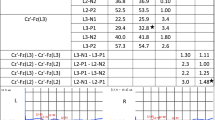Abstract
Since the first papers on evoked potential studies in clinical practice1–5. a number of reports have appeared covering spinal disease6–10. Only very few papers with segmental application of SEP recording in spinal disease have come to our knowledge. In the last three years, we have carried out nearly 600 examinations with segmental SEP recordings. In this paper we present our experience with a number of patients referred with a suspected spinal cord lesion and describe the results from the clinical application of (poly-) segmental recorded SEP. The possible value of patterns of SEP alteration as a better criterion of abnormality was investigated. We attempted to clarify the advantages of the segmental recording technique and to determine whether particular disease processes have a specific SEP pattern.
Access this chapter
Tax calculation will be finalised at checkout
Purchases are for personal use only
Preview
Unable to display preview. Download preview PDF.
Similar content being viewed by others
References
Alajouanine, Th., Scherrer, J., Barbizet, J., Calvet, J. and Verley R. (1958). Potentials évoqués corticaux chez des subjets atteints de troubles somesthésiques. Rev. Neurol, 98, (6)
Bergamini, L., Bergamasco, B., Fra, L., Gandiglio, G., Mombelli, A. M. and Mutani, R. (1966). Réponses corticals et périphériques évoquées par stimulation dur nerf dans la pathologie des cordons postérieurs. Rev. Neurol, 115, 99
Giblin, D. R. (1964). Somatosensory evoked potentials in healthy subjects and in patients with lesions of the nervous system. Ann. N. Y. Acad. Sci, 112, 93
Halliday, A. M. and Wakefield, G. S. (1963). Cerebral evoked potentials in patients with dissociated sensory loss. J. Neurol Neurosurg. Psychiat., 26, 211
Namerow, S. (1968). Somatosensory evoked responses in multiple sclerosis patients with varying sensory loss. Neurology, (Minneap.), 18, 1197
Baust, W., Ilsen, H. W., Jörg, J. and Wambach, G. (1972). Höhenlokalisation von Rückenmarksquerschittssyndromen mittels corticaler Reizantwortpotentiale, Nervenarzt, 43, 292
Baust, W., Ilsen, H. W., Jörg, J. and Wambach, G. (1972). A neurophysiological method for the localization of transverse lesions of the spinal cord. Acta Neurochir. (Wien), 26, 352
Jörg, J. (1974). Die cervicale Myelophathie als differentialdiagnostische Erwägung bei Gehstörungen im mittleren und höheren Alter. Nervenarzt, 45, 341
Kondo, M. (1977). Clinical study of somatosensory evoked potentials (SEPs) in orthopaedic surgery. Int. Orthopaed. (SICOT), 1, 9
Schramm, J. and Hashizume, K. (1977). Somatosensory evoked potentials (SEP) in patients with peripheral, spinal and supraspinal lesions of the sensory system. Adv. Neurosurg., 4, 250
Jörg, J. (1977). Die elektrosensible Diagnostik in der Neurologie. Neurology series (Berlin: Springer)
Taylor, A. R. (1968). Vascular factors in the myelopathy associated with cervical spondylosis. Neurology, (Minneap.) 14, 62
Fukushima, T. and Mayangi, Y. (1975). Neurophysiological examination (SEP) for the objective diagnosis of spinal lesions. Adv. Neurosurg., 2, 158
Nakanishi, L Shimada, Y. and Toyodura, Y. (1974). Somatosensory evoked responses to mechanical stimulation in normal subjects and in patients with neurological disorders. Neurol. Sci., 21, 289
Cracco, Q. (1975). Clinical applications of averaged evoked responses to somatic stimulation. Int. J. Neurol, 9, 233
Editor information
Editors and Affiliations
Rights and permissions
Copyright information
© 1980 MTP Press Limited
About this chapter
Cite this chapter
Schramm, J., Oettle, G.J., Pichert, T. (1980). Clinical application of segmental somatosensory evoked potentials (SEP) — experience in patients with non-space occupying lesions. In: Barber, C. (eds) Evoked Potentials. Springer, Dordrecht. https://doi.org/10.1007/978-94-011-6645-4_53
Download citation
DOI: https://doi.org/10.1007/978-94-011-6645-4_53
Publisher Name: Springer, Dordrecht
Print ISBN: 978-94-011-6647-8
Online ISBN: 978-94-011-6645-4
eBook Packages: Springer Book Archive




